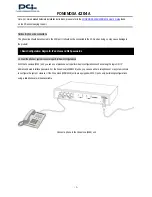
C
ONTROL
V
OLTAGE
T
HEORY
The concept of control voltage (CV) is not hard to understand: Instead of turning a knob on your pedal, you
simply connect a voltage – the control voltage – to the corresponding CV input that does the job for you.
So for example if you want to have a quickly varying LFO SYMMETRY you don't have to turn that knob all
the time, back and forth until your fingers fall off, but simply connect an alternating CV to the LFO
SYMMETRY input.
You can use control signals from any source to manipulate certain
features of the RH301. All of the CV inputs of the RH301 accept
bipolar as well as unipolar control voltages, but work best with CV
from 0 – 5V. The incoming CV signals are mixed together with the
corresponding knob on the RH301 itself and we provide you with a
attenuator for each CV input on the backside of the panel.
Fig.4 Backpanel Features
If you notice a significant distortion or clipping in your control signal waveform or strange CV behavior
simply turn the attenuator counter-clockwise (towards the word 'CV') until you hear your desired result. By
turning it counter-clockwise you attenuate the incoming CV signal. Fully counter-clockwise means that the
incoming CV signal is completely gone, whereas fully clockwise means that the incoming CV signal is arriving
to the circuit unattenuated. Furthermore you can set an offset voltage to your control voltage to adjust the
CV signal to your needs. The offset voltage is set by the corresponding knob on the front panel (LFO RATE
and LFO SYMMETRY). There's also a distinction between bipolar and unipolar signals. This is best explained
with a few pictures:
So, what happens? The incoming CV signal is shifted around the voltage that you select with the
corresponding knob. Example: if you insert a -5V to +5V sine wave into the LFO SYMMETRY CV jack you
will get the following results while turning the SYMMETRY knob:
A similar thing happens to unipolar CV signals: Their point of origin (0V) is shifted by the amount set with
the corresponding knob. In other words: You add the voltage of your knob to the voltage of your incoming
unipolar CV signal. Now that you know more about CV, let's see what the patch bay has to offer!
KOMA Elektronik RH301 – Rhythm Workstation / Utility Tool
Page 10





















